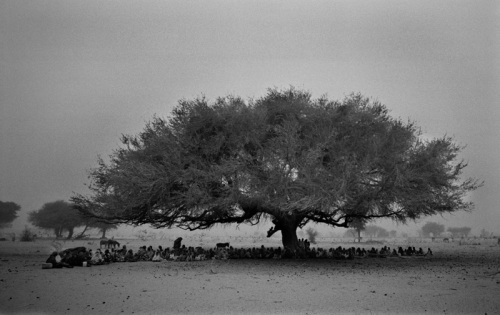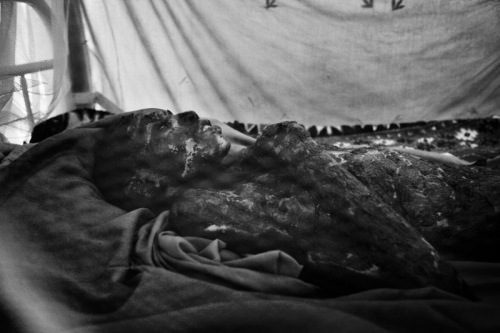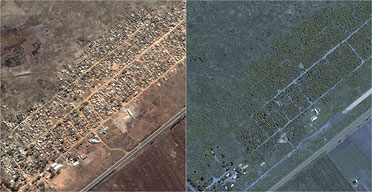Last week, I was able to attend a panel with a Kennedy School professor, a member of Physicians for Human Rights, and a photojournalist who worked in the Darfur region. Here are some of the things that I picked up at the event.
Photojournalist Marcus Bleasdale was in the region from in the region from 2003 until 2008. He traveled there about 12 times in that period to Chad, Darfur and Central African Republic. He documented the plight of villagers as they tried to escape the janjaweed for refugee camps within Darfur and in Chad. He was kind enough to allow me to post a few of his pictures from that time on this blog.
He mentioned how at the sound of airfare or helicopters, entire villages would cluster around huge trees so that it would shield them from the bombs. This was happening to hundreds of villages in Darfur while they were moving from their homes to the camps. It is hard to fathom until you see some of the pictures he has taken.

Sudanese displaced take refuge under a tree in Disa, Northern Darfur out of the heat of the day and out of view of the Antanov responsible for the bombing, there are estimated to be 2,000,000 displaced in Darfur who are trapped on the east, west and south by government troops and in the north by the desert wasteland which will certainly claim the lives of their livestock and weaker members of their family. Photo by Marcus Bleasdale
There is reason for them to hide as the Sudanese army/ janjaweed was throwing phosphorous bombs from the back of helicopters and planes. The results are horrific, and I’ll let Marcus’s photo do the talking.

Abakar Tidjani 17 years old lies in bed in Abeche suffering from 3rd degree burns to 80% of his body. He was playing with a grenade when it exploded. Photo by Marcus Bleasdale
What seemed to outrage Marcus the most is that the refugees could live in make shift shelters waiting months for assistance outside the camps without any hope of assistance. He asks, “how can the international community allow this to happen?” No human should have to feel like animals stripped of dignity.

Sudanese Refugees in Eastern Chad wait to register in the Tulum refugee camp. Supplies of food and water are sporadic and moving into the rainy season the supply route will get worse. Photo by Marcus Bleasdale
There are currently 3 million internally displaced people (IDP’s) in the region. At the camps, families make the conscious decision to send the women to fetch for firewood even though they are raped by militia/ janjaweed, and even men from the camps during their journey because the alternative would be death for the men.
It is nearly impossible to prosecute any man of rape under current Sudanese law. For a successful prosecution, the victim would need 4 male eyewitnesses to support your claim or 8 female eyewitnesses. There is tremendous stigma associated with rape, so the women do not talk about it. They fear that they will be accused of adultery or so defiled that they are not worth marrying.
Even though the Bush administration declared Darfur a genocide, the government was slow to act because Sudan was helping with US intelligence in the Middle East. The Obama administration has been preoccupied with other issues like health care, the economy, and Afghanistan/ Pakistan.
Thirteen international non-government organizations were kicked out, and 3 Sudanese aid groups were shut down after the International Criminal Court issued its arrest warrant for president Omar Bashir. This has left a tremendous void for the people.
The only way forward is to put pressure on China to cancel their contracts for Sudanese oil and for Chinese weapons that Omar Bashir is providing the janjaweed. This would be economically difficult for America to ask of China.
Ideally, the international community would force China’s hand using the ICC’s decision as its basis. Money talks, and the World Trade Organization (WTO) could put pressure on China by forcing it to pay tax on key exports for dealing with a criminal. China has an unfair economic advantage because other countries are not willing to deal with a human rights violator for its oil.
China should pay the consequences for its economic activity because their business is abetting a genocide. Unfortunately, this will continue as it has made deals with the Guinean dictator despite soldiers involved in mass rape and killings during a protest earlier this year.
This can only be stopped if China is punished. The question is, “Does the international community have the political will to make this happen?” Unfortunately, we may already know that answer.
Special Thanks to Marcus Bleasdale for his work and for allowing me to post some of his pictures on our blog. I encourage you to check out his website and take 10 minutes to watch a piece he did on the conflict in the Congo.
